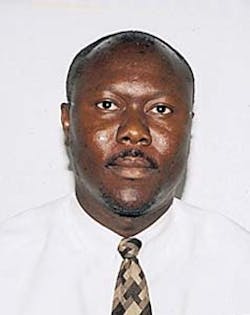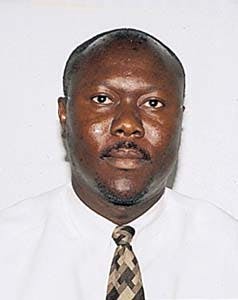New PDC cutters improve drilling efficiency
Graham Mensa-WilmotNew polycrystalline diamond compact (PDC) cutters increase penetration rates and cumulative footage through improved abrasion, impact, interface strength, thermal stability, and fatigue characteristics.
GeoDiamond
Houston
Studies of formation characterization, vibration analysis, hydraulic layouts, and bit selection continue to improve and expand PDC bit applications.
Development philosophy
The importance of drill bits in well economics has been overlooked because bit costs are low in comparison to overall well costs. This philosophy is changing because efficient drill bit performance affects penetration rates and drilling duration, resulting in reduced operational costs.Developments in PDC cutter technology now provide solutions that formerly impeded bit development. These developments, combined with effective PDC bit selection, caused a reevaluation of the philosophy behind cutter development. Specially designed cutters are now being developed for customized bit types to make them more effective in intended applications.
To sustain and build on current performance levels, continuous improvements have to be made to all features that affect PDC bit performance, especially cutter development.
Just as different bits are required for different formations, specific cutter types are needed for a variety of bit applications and drilling environments. As bit profiles, blade count, cutter size, and hydraulic requirements change, so will the requirements and characteristics of the cutters needed to ensure efficiency.
This development philosophy is having enormous effects in reducing drilling costs.
Performance characteristics and requirements
The inverse relationships between abrasion, impact, thermal stability, interface strength, and fatigue have previously limited PDC cutter development. Improvements in any particular characteristic were normally achieved at the expense of others.The two most important performance qualifiers for a PDC cutter are the impact and abrasion resistances. Similar to the others, these two qualifiers normally exhibit an inverse relationship shown in Equation 1.
A * I = K1 (1)
where:
A = Abrasion resistance
I = Impact resistance
K1 = Constant of proportionality.
Although these characteristics were once used to quantify PDC cutter development, a new set of requirements has been identified.
Without compromising PDC bit design objectives, cutters are now required to:
- Ensure a judicious use of the energy supplied to the bit
- Minimize rate of wear-flat generation
- Reduce torque generation and increase footage
- Extend the duration of the shearing action
- Minimize heat checking
- Extend the life of diamond tables.
Type A cutter
PDC bit performance has improved through the use of Type A cutters shown in Fig. 1.This cutter has a uniquely configured, grid-like carbide interface geometry with a sloping periphery (Fig. 1a [5,317 bytes]).
Its non-planar interface has been engineered to reduce the magnitude of the cutter's damaging residual stresses, and to relocate the stresses away from the periphery. In addition, the geometry reduces the cutter's stress gradients.
In comparison to conventional cutters, Cutter A has a thicker diamond table (Fig. 1b). Prior to this development, diamond table thickness was limited because the diamond substrate and tungsten carbide substrate had a flat mating surface. This produced very high residual stresses because of the sintering process and because there are differences between the mechanical and thermal properties of the diamond table and tungsten carbide substrate.
With the Type A cutter, its grid-like interface increases the bond area between the diamond and carbide substrates. The interface geometry deflects fractures, making them approximately perpendicular to their originating planes. The Type A cutter optimizes drilling performance by enhancing abrasion, impact, and burst strengths.
Bits with proven performances are redefining their application limits upon being refitted with Cutter A. Table 1 [22,402 bytes] compares the run data of a 121/4-in. (M333) bit after two separate runs. The bit was first run with conventional cutters, after which it was rebuilt and rerun in the same application using the Type A cutters.
Using conventional cutters in the first run, the bit averaged 26.7 ft/hr over an interval of 2,701 ft. This was better than average area offset values of 25 ft/hr and 885 ft, respectively. The bit drilled the upper and part of the lower Wilcox formation saving $104,742 in drilling costs.
The bit was then rebuilt with Cutter A, and rerun in a similar application under identical conditions. In the second run, the bit drilled 5,814 ft at an average penetration rate of 28.2 ft/hr. It drilled the entire Wilcox section and a substantial portion of the Midway shale. The second run saved $193,606 in drilling costs and more than doubled the footage as compared to the first run. Fig. 2 [11,182 bytes] shows the wear on the bit after the second run with Cutter A.
Type B cutter
Cutter Type B enhances PDC bit development and performance levels above that of cutter Type A. It has two diamond cutting edges consisting of a primary diamond table and a secondary diamond ring (Fig. 3 [5,574 bytes]). The primary cutting edge was developed along guidelines similar to that of Cutter A.The secondary cutting edge is located within the carbide cutter body and is flush with the carbide cylinder.
Cutter B's primary cutting edge works in a manner similar to that of Cutter A. However, as wear flats develop during the drilling process, Cutter B's secondary cutting edge becomes exposed. The secondary cutting edge reinforces and prolongs the cutters' life by reducing the rate of wear to the carbide substrate. Fig. 4 [154,582 bytes] illustrates wear-flat comparisons for all conventional, Type A, and Type B cutter types.
The comparatively smaller wear flats generated on Cutter B help sustain its shearing rock-removal mechanism. In addition, smaller wear flats generate less heat, require reduced weight on bit, and decrease the cutters' reactive torque.
Fig. 5a [6,585 bytes] and Fig.5b [6,006 bytes] shows both conventional and Type B cutters taken out of a bit. The two cutters were placed in the bit under identical design, loading, and work rate conditions.
The presence of the secondary cutting edge added approximately 30% more diamond volume to Cutter B, in comparison to Cutter A. This additional volume can be increased by modifying the secondary cutting edge's geometric parameters.
Because abrasion resistance is directly proportional to the total available diamond volume (Equations 2 and 3), the Type B cutter benefits most when the impact resistance of a cutter is optimized. When the impact resistance is optimized, then the abrasion resistance increases as total diamond volume increases.
when:
I = Iopt (2)
then:
A = K2*Dv (3)
Dv = Total diamond volume
A = Abrasion resistance
K2 = Proportionality constant
Iopt = Optimum impact resistance of the cutter.
This advantage permits optimization of bit features such as cutter size, bit profile, cutter layout (cutting structure), blade count, void-volume ratio, and nozzle layout.
Fig. 6a [18,199 bytes] and Fig.6b [13,633 bytes] compares two identical bits, X and Y (IADC classification M432), run in a comparative field test in a hard and abrasive formation. Bit X was built with Type B cutters, and Bit Y was built with conventional cutters.
Although the prior conventional run was economical, penetration rates and footage improved by 55% and 142%.
Type C cutter
The Type C cutter has a stress-engineered relief channeled in its tungsten carbide substrate (Fig. 7 [10,384 bytes]). An offset, a tangency, and leading and trailing angles define the asymmetrical shape of the relief (Fig. 8 [4,723 bytes]).The offset is the distance at which the leading angle is initiated. It is measured from the interface or adjacent surfaces between the diamond table and carbide substrate.
The leading and trailing are the angles closest and furthermost from the offset, respectively. The distance from the offset, at which the leading and trailing angles meet, defines the tangency.
At the commencement of drilling, Cutter C embeds a small portion of its tungsten carbide substrate into the formation being dislocated (Fig. 8). This property reduces the applied bit weight required to establish shearing in order to achieve penetration rates.
The lower bit-weight requirement minimizes wear-flat generation, while the reduction in the substrate portion embedded in the formation reduces its torque. This is because the tungsten carbide portion of the cutter has a higher coefficient of friction than the diamond table.
During wear-flat generation, the leading and trailing angles of the cutters' engineered relief minimizes the carbide surface area that is dragged or pushed into the formation in order to establish an effective depth-of-cut.
This enhancement curtails the rate of wear-flat generation, increases penetration rates, minimizes torque, reduces heat checking, and extends the life of the cutter. The unique relief enhances carbide substrate cooling by permitting drilling fluid entrapment behind the cutter's diamond table.
The location, proximity, and direction of this entrapped fluid with respect to the cutters' diamond table enhances cooling and extends the cutters' life. Fig. 9 [6,326 bytes] shows the reduced wear-flat area promoted by the engineered relief of the Type C cutter.
Combinations
The three cutter types (A, B, and C) can be combined in various forms to further enhance PDC bit performance. Fig. 10 [9,184 bytes] shows a Type D cutter, with a stress-engineered interface different than Type A, that combines the features of Cutters B and C.Evaluation is in progress of the Type E cutter that benefits from the stress-reducing advantages of nonplanar interfaces. The cutter incorporates a new processing technology that enables maximization of its diamond table thickness without compromising its optimized impact resistance. Cutter E has the thickest diamond table in the drilling industry. Evolution of this cutter will include addition of the features described for Cutters B and C.
Acknowledgment
The author wishes to thank Richard Hill, Halle Aslaken, Humberto Gonzalez, and Diane Jordan for their contributions towards this article.Bibliography
Mensa-Wilmot, G., and Truax David, "Twin Edge Cutter (TEC)-Enhancing PDC Bit Development and Performance," SPE/IADC paper 37637, March 1997.Warren, T.M., Sinor, L.A., "PDC Bits-What's Needed to Meet Tomorrow's Challenge," SPE paper 27978, August 1994.
Mensa-Wilmot, G., and Alexander, W., "New PDC bit design reduces vibrational problems," OGJ, May 22, 1995.
Brett, J.F., Warren, T.M., and Behr, S.M., "Bit Whirl-A New Theory of PDC Bit Failure," SPE paper 19571, October 1989.
Perrin, V.P., Mensa-Wilmot, G., and Alexander, W., "Drilling Index-A New Approach to Bit Performance Evaluation," SPE/IADC paper 37595, March 1997.
Fear, M.J., Meany, N.C., and Evans, J.M., " An Expert System for Drill Bit Selection," SPE/IADC paper 27470, February 1994.
Graham Mensa-Wilmot is the manager of technology development at GeoDiamond, a business unit of Smith International Inc. in Houston. He holds an MS in drilling engineering from the Oil & Gas Institute of Ploiesti, Romania. Mensa-Wilmot is involved in the engineering and development of PDC bits, mostly researching the identification and mitigation of their vibrational characteristics. He has previously worked as a directional driller and has broad experience in PDC bit applications.
Copyright 1997 Oil & Gas Journal. All Rights Reserved.

